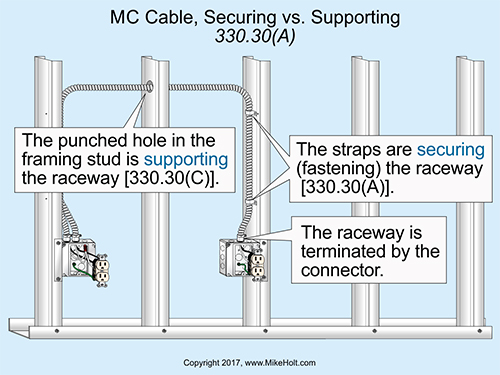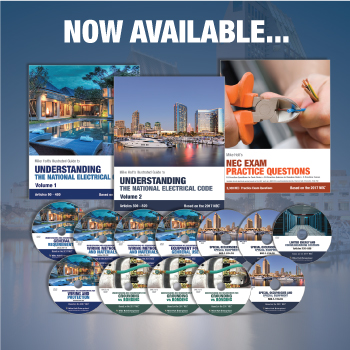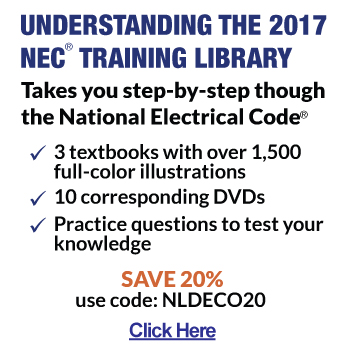|
Note: The answers to these questions are based on the 2017 NEC®.
Underlined text indicates a change in the rule for the 2017 NEC.
Q1. What are the NEC listing requirements for Metal-Clad (Type MC) cable and fittings?
A1. Type MC cable must be listed. The fittings must be listed and identified for the use [330.6].
Author’s Comment:
- Type MC cable is made with several types of metal sheaths. Steel and aluminum are the most common. It can also have a PVC jacket for supplemental protection. Fittings must be listed and identified for the specific type of MC cable being installed.
- Type AC cable connectors can also be used if the fitting or container indicates that they can also be used for the Type MC cable being installed.
- The NEC doesn’t require anti short bushings (red heads) at the termination of Type MC cable, but if they’re supplied it’s considered by many to be a good practice to use them.
Q2. What are the NEC requirements for supporting and securing Metal-Clad (Type MC) cable?
A2. Type MC cable must be supported and secured by staples, cable ties listed and identified for securing and supporting; straps, hangers, or similar fittings; or other approved means designed and installed so as not to damage the cable [330.30(A)].
Author’s Comment:
Secured is “fastened” such as with a strap or tie wrap; supported is “held” such with as a hanger or through a hole in a stud, joist, or rafter. Figure 1
Type MC cable with four or fewer conductors sized no larger than 10 AWG, must be secured within 12 in. of every outlet box, junction box, cabinet, or fitting and at intervals not exceeding 6 ft [330.30(B)].
Listed Type MC cable with ungrounded conductors 250 kcmil and larger can be secured at 10 ft intervals when installed vertically.
Type MC cable must be supported at intervals not exceeding 6 ft. Cables installed horizontally through wooden or metal framing members are considered secured and supported if such support doesn’t exceed 6 ft intervals [330.30(C)].
Type MC cable can be unsupported and unsecured where [330.30(D)]:
(1) Fished through concealed spaces in a finished building and support is impractical.
(2) Not more than 6 ft long from the last point of cable support to the point of connection to a luminaire or electrical equipment within an accessible ceiling. For the purposes of this section, Type MC cable fittings are permitted as a means of cable support.
(3) Not more than 3 ft from the last point where it’s securely fastened to provide flexibility for equipment that requires movement after installation, or to connect equipment where flexibility is necessary to minimize the transmission of vibration from the equipment.
Q3. What are the NEC requirements for supporting and securing Nonmetallic-sheathed (Type NM) cable?
A3. Nonmetallic sheathed cable must be supported and secured by staples, straps, cable ties listed and identified for securing and supporting; hangers, or similar fittings, at intervals not exceeding 4½ ft and within 12 in. of the cable entry into enclosures or fittings [334.30].
Two wire (flat) Type NM cable isn’t permitted to be stapled on edge.
Type NM cable installed within a raceway isn’t required to be secured within the raceway.
Type NM cable installed horizontally in bored or punched holes in wood or metal framing members, or notches in wooden members is considered secured and supported if the distance doesn’t exceed 4½ ft. Type NM cable must also be secured within 1 ft of termination [334.30(A)].
Informational Note: See 314.17(C) for support where nonmetallic boxes are used.
Unsupported Type NM cable is permitted for the following situations [334.30(B)]:
(1) Where Type NM cable is fished between concealed access points in finished buildings, and support is impracticable.
(2) Not more than 4½ ft of unsupported cable is permitted from the last point of support within an accessible ceiling for the connection of luminaires or equipment in one-, two-, or multifamily dwellings.
Author’s Comment:
Type NM cable isn’t permitted as a wiring method above accessible ceilings, except in dwellings [334.12(A)(2)].
Q4. What uses are permitted by the NEC for Nonmetallic-sheathed (NM) cable?
A4. Type NM and Type NMC cables can be used in the following [334.10], except as prohibited in 334.12:
(1) One- and two-family dwellings of any height, and their attached/detached
garages or storage buildings.
(2) Multifamily dwellings permitted to be of Types III, IV, and V construction.
(3) Other structures permitted to be of Types III, IV, and V construction. Cables must be concealed within walls, floors, or ceilings that provide a thermal barrier of material with at least a 15-minute finish rating, as identified in listings of fire-rated assemblies.
Author’s Comment:
See the definition of “Concealed” in Article 100.
Informational Note 1: Building constructions are defined in NFPA 220-2015, Standard on Types of Building Construction, the applicable building code, or both.
Informational Note 2: See Annex E of the NEC for the determination of building types [NFPA 220, Table 3-1].
(4) Cable trays permitted in Types III, IV, or V structures where the cable is identified for the use.
(5) Where within raceways permitted to be installed in Types I and II construction.
Q5. What uses are permitted by the NEC for Power and Control Tray Cable (Type TC)?
A5. Uses Permitted [336.10]:
(1) Power, lighting, control, and signal circuits.
(2) In cable trays including those with mechanically discontinuous segments up to 1 ft.
(3) In raceways.
(4) Outdoor locations supported by a messenger wire.
(5) Class 1 circuits as permitted in Parts II and III of Article 725.
(6) Nonpower limited fire alarm circuits if in accordance with 760.49.
(7) Industrial establishments where the conditions of maintenance and supervision ensure that only qualified persons service the installation.
(8) In wet locations where the cable is resistant to moisture and corrosive agents.
(9) In one- and two-family dwellings, Type TC-ER cable is permitted in accordance with Part II of Article 334.
Author’s Comment:
The “ER” marking on Type TC-ER cable identifies the cable as suitable for exposed run use in accordance with UL 1277.
Ex: Where Type TC cable is used to connect a generator and its associated equipment, the cable ampacity limitations of 334.80 or 340.80 don’t apply.
Informational Note 1: Type TC cable that’s suitable for pulling through structural members of a dwelling unit will be marked “TC-ER-JP.”
Author’s Comment:
The “JP” marking on Type TC-ER-JP cable identifies the cable as suitable to be pulled through wood framing members because the cable has met the joist pull testing requirements of UL 1277.
Informational Note 2: Control and Class 1 power conductors within the same Type TC cable are only permitted where the conductors are functionally associated with each other in accordance with 725.136.
(10) Direct buried where identified for direct burial.
|



